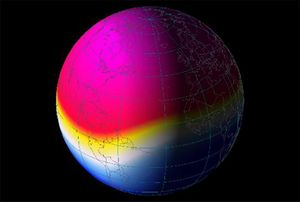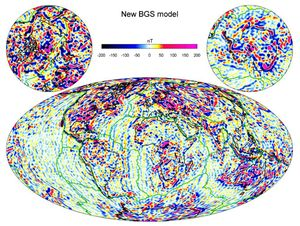OR/16/030 Developments in global magnetic field modelling
| Thomson, Alan W P. 2016. Geomagnetism review 2015. British Geological Survey Internal Report, OR/16/030. |

Every year BGS produces global models that describe the magnetic field of the Earth from the surface of the core to the upper reaches of the atmosphere. During 2015 our main model developments concerned improving model resolution both in space and in time. Beyond scientific interests, these models are also used to derive the annual BGS Global Geomagnetic Model (BGGM), for directional drilling purposes, and are also used to monitor accuracy of the World Magnetic Model and the International Geomagnetic Reference Field, which are only updated once every 5 years.
The models
Our global geomagnetic field models are spherical harmonic (SH) models that represent the major components of the Earth’s magnetic field: the main or core-generated field, the crustal field and the external field. BGS models provide a more comprehensive representation of the magnetic field compared to that of the solely main field content of the World Magnetic Model (WMM) or of the International Geomagnetic Reference Field (IGRF).
Time variations in the main and external fields are part of BGS models while the lithospheric field is considered static. Our models are built using iterative least squares inversion and described by SH coefficients that are a fit to observations from the observatory network and from data from satellites orbiting the Earth.
Continuing advances


For the BGGM several notable features have been added or enhanced this year:
- inclusion of latest data, allowing prediction of the field to 2017
- improved time dependence of main and external fields
- increased resolution of lithospheric field features down to ~300 km (SH degree 133)
- consistent spectral content from 1900–present
These advances have been achieved in a variety of ways. Re-analysis of satellite data from the Danish Ørsted (1999–2014), German CHAMP (2000–2010) and ESA Swarm (2013–present) satellite missions has allowed better representation of the temporal variations from 1999 to the present. Combined with prompt production of observatory data, this improves the ability to make predictions of near-future variations in the field. By also analysing historical observations, the variations of the main and external fields have been modelled back to the year 1900 and integrated with a high-resolution model of the static lithospheric field to give a consistent spectral description throughout this period.
Lithospheric field
Perhaps the most notable advance is the increased resolution of the lithospheric field to SH degree 133, allowing resolution of features on the scale of ~300 km at the Earth’s surface. To achieve this a revamped modelling scheme has been applied, in combination with more extensive use of satellite scalar magnetic intensity data at high latitudes and CHAMP and Swarm gradient data. While field gradients along a satellite’s track could already be estimated from CHAMP data, it is the Swarm mission, with its three satellite constellation, that allows the use of gradients between adjacent tracks.
Gradient data, being the difference between measurements at two positions at similar times, are sensitive to small-scale features in the field. Resolution increases are more dramatic in high latitude regions but all regions are improved. It is expected that as the Swarm mission evolves and orbit heights decay, further improvements in resolution down to ~266 km (SH degree 150) may be possible.
WMM accuracy
BGS updates the WMM every 5 years in collaboration with US partners. In between each model update we add to datasets, develop modelling capability and monitor the performance of the last update. WMM2015 (produced in late 2014) continues to meet accuracy requirements.